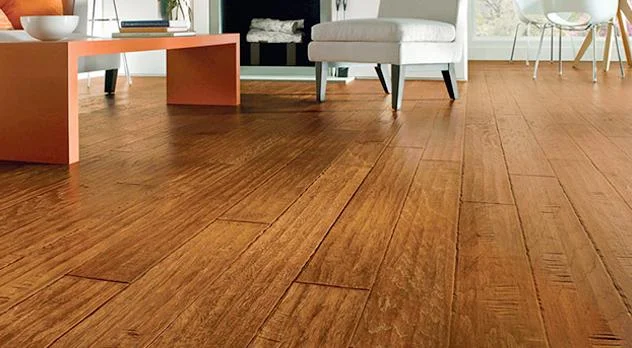Choosing hardwood flooring can feel overwhelming with countless options flooding the market. Each type offers distinct advantages and drawbacks that impact both your budget and your home's long-term value. While the rich warmth and natural beauty of wood floors appeal to most homeowners, understanding the technical differences between solid and engineered options will help you make a choice you'll love for decades.
The decision goes far beyond selecting a beautiful wood species or finish color. Construction methods, thickness variations, and moisture resistance all play crucial roles in determining which flooring will thrive in your specific environment. Whether you're renovating a century-old home or building new construction, the right hardwood choice depends on understanding how different products perform under various conditions.
At Creative Floors, we've helped Chicago-area homeowners navigate these decisions for years. Our experience has shown that informed buyers who understand the fundamentals make choices they're still happy with decades later. Let's explore the key factors that should guide your hardwood flooring investment.
Understanding Solid vs. Engineered Hardwood Construction
Solid hardwood represents the traditional approach to wood flooring. Each plank consists entirely of one piece of wood, typically milled from hardwood species like oak, maple, or cherry. This construction method has remained largely unchanged for centuries because it works exceptionally well under the right conditions.
Engineered hardwood takes a more modern approach to construction. These planks feature a real hardwood veneer (called the wear layer) bonded to multiple layers of plywood or high-density fiberboard underneath. This layered construction creates a product that looks identical to solid wood from the surface but behaves very differently when exposed to environmental changes.
The manufacturing process for engineered wood involves cross-layering the core materials, which counteracts the natural tendency of wood to expand and contract with moisture changes. This engineering creates dimensional stability that solid wood simply cannot match.
Both options can feature identical surface appearances, finishes, and wood species. The difference lies entirely in how they're constructed and how they respond to installation challenges and environmental conditions over time.
Why Thickness Matters in Your Hardwood Selection
Thickness significantly impacts both performance and longevity, particularly with solid hardwood options.
¾-Inch Solid Hardwood: The Gold Standard
Traditional ¾-inch solid hardwood offers unmatched durability and refinishing potential. These thick planks can be sanded and refinished numerous times throughout their lifespan, some floors have been refinished 8-10 times over a century of use. This thickness provides the substantial feel underfoot that many homeowners associate with premium hardwood flooring.
However, this thickness comes with installation limitations. You cannot install ¾-inch solid hardwood directly over concrete subfloors, and the material's substantial mass makes it more susceptible to moisture-related movement. Creative Floors typically recommends this option for upper floors with proper wood subfloors in homes with controlled humidity levels.
Thinner Solid Options: 5/16, 3/8, and ½-Inch Profiles
Thinner solid hardwood planks offer more installation flexibility while maintaining the authentic solid wood construction. These profiles adapt better to moisture variations and can handle slightly more humid environments than their thicker counterparts.
The trade-off involves reduced refinishing potential and a less substantial feel underfoot. Thinner planks may only accommodate 2-3 refinishing cycles compared to the numerous refinishing opportunities with ¾-inch material.
These thinner options still require wood subfloors and cannot be installed directly over concrete, maintaining many of the same installation restrictions as thicker solid wood.
Moisture Sensitivity and Installation Limitations
Moisture represents the biggest challenge for solid hardwood flooring. Wood naturally expands when it absorbs moisture and contracts when it dries out. This movement can cause cupping, warping, or gapping between planks if not properly managed.
Climate Considerations
Solid hardwood performs best in
regions with stable humidity levels year-round. Chicago's varying seasonal conditions require proper
HVAC systems that maintain consistent indoor humidity between 30-50%. Homes without adequate climate control
may experience seasonal wood movement that creates gaps in winter and potential cupping in summer.
Subfloor Requirements
Never install solid hardwood
directly over concrete slabs. The concrete can trap moisture and transfer it to the wood, causing
significant damage over time. Solid hardwood requires a wood subfloor system that allows air circulation and
provides proper nailing surfaces.
Below-Grade Restrictions
Basements and other below-grade
installations are generally unsuitable for solid hardwood due to increased moisture potential and concrete
subfloor requirements.
The Stability Advantages of Engineered Hardwood
Engineered hardwood's layered construction creates remarkable dimensional stability. The cross-grain layers in the core counteract the surface wood's natural expansion tendencies, resulting in a product that moves significantly less than solid wood.
Installation Versatility
This stability opens up installation possibilities that solid wood cannot accommodate:
- Direct installation over concrete slabs
- Below-grade applications including finished basements
- Radiant heating systems
- Areas with higher humidity fluctuations
Performance in Challenging Environments
The engineered construction allows these floors to perform well in conditions where solid hardwood would struggle. Bathrooms, kitchens, and other areas with occasional moisture exposure become viable options with proper installation techniques.
Quality Considerations
Not all engineered hardwood offers equal performance. Look for products with substantial wear layers (at least 3mm thick) and high-quality core construction. Premium engineered floors from reputable manufacturers can provide decades of service while maintaining their appearance.
The factory-applied finishes on most engineered products offer excellent durability and consistency compared to site-finished solid wood options.
Making Your Final Decision
Your choice between solid and engineered hardwood should align with your specific installation conditions, budget, and long-term plans for your home.
Choose solid hardwood when:
- Installing over wood subfloors in above-grade areas
- Seeking maximum refinishing potential for century-long performance
- Prioritizing the traditional solid wood feel and substantial thickness
- Working with controlled indoor climate conditions
Choose engineered hardwood when:
- Installing over concrete slabs or in below-grade areas
- Dealing with moderate humidity fluctuations or radiant heating
- Prioritizing installation flexibility and dimensional stability
- Seeking the authentic hardwood appearance with enhanced performance
At Creative Floors, we've seen both solid and engineered hardwood deliver exceptional results when properly matched to the installation environment. Our team helps Chicago-area homeowners evaluate their specific conditions and choose the option that will provide decades of beauty and performance.
The investment you make in quality hardwood flooring, whether solid or engineered, will enhance your home's value and provide enjoyment for generations. Take time to consider your specific needs, consult with experienced professionals, and choose the option that best fits your unique situation.

